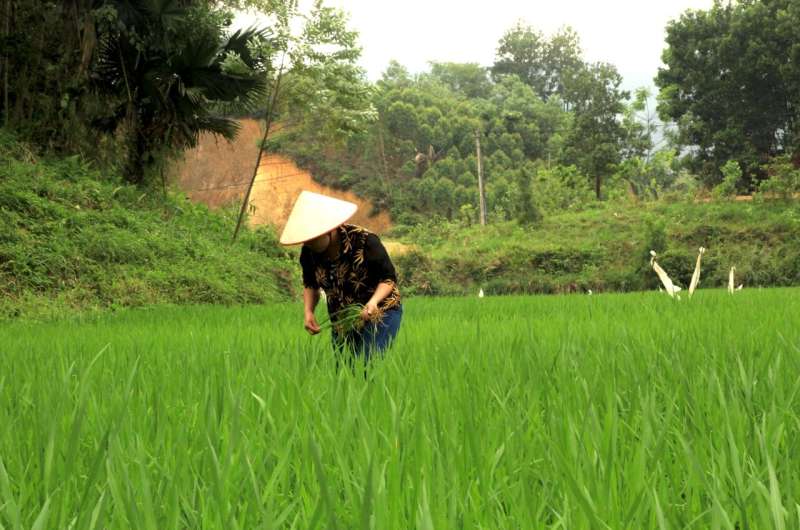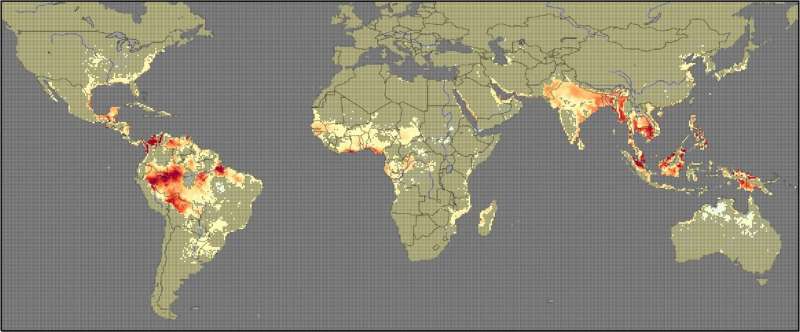This article has been reviewed according to Science X's editorial process and policies. Editors have highlighted the following attributes while ensuring the content's credibility:
fact-checked
proofread
In many major crop regions, workers plant and harvest in spiraling heat and humidity

A global study of major crops has found that farmworkers are being increasingly exposed to combinations of extreme heat and humidity during planting and harvest seasons that can make it hard for them to function. Such conditions have nearly doubled across the world since 1979, the authors report, a trend that could eventually hinder cultivation.
The most affected crop is rice, the world's number one staple, followed closely by maize. As temperatures rise, the trend has accelerated in recent years, with some regions seeing 15-day per-decade increases in extreme humid heat during cultivation seasons.
The study was just published in the journal Environmental Research Communications.
"If this affects humans' ability to grow food, that's serious," said lead author Connor Diaz, who did the research as a Columbia University undergraduate student with scientists at the university's Lamont-Doherty Earth Observatory. "The global food chain is all connected, and the danger is, this will impact crop production."
Higher temperatures alone are oppressive, but high relative humidity greatly increases the effects. We cool our bodies by expelling sweat, which contains excess body heat; then, when the sweat evaporates, that heat is carried away. But the more the air is laden with moisture, the less efficiently evaporation can take place—the reason muggy days feel so bad. High humidity is especially prevalent in major tropical and subtropical crop regions in river deltas and near coasts, which supply plenty of moisture for the air to soak up.
Multiple recent studies have already documented increases in extreme combinations of heat and humidity across the world. A 2021 study by Columbia scientists found that the number of city dwellers exposed to extreme humid heat has tripled since the 1980s, affecting more than a fifth of the world population. A 2020 study also out of Columbia found that potentially fatal heat-humidity combinations previously not predicted to appear until mid-century are already popping up in many areas. The new study is the first to look at the effects on farmworkers specifically during cultivation seasons.
Combined heat and humidity are gauged on the "wet bulb" scale, which factors in air temperature, water-vapor content and wind conditions. The authors of the new study define 27°C wet-bulb as the point where farmworkers will begin struggling. Depending on the exact combination of conditions, this would be equivalent to between 86°F and 105°F on "real feel" heat indexes used by popular media.
Some earlier studies have defined 30°C wet bulb—roughly 106°F or more "real feel"—as extreme for everyday tasks, but farmworkers toiling under direct sun many hours a day may crumble well before that.
The new study found that many major agricultural regions already experience three months of 27°C conditions or worse during the year as a whole. These include the Amazon, northern Colombia and parts of Mexico; the coasts of the Red Sea and Persian Gulf; southeast Asia; and much of Malaysia and Indonesia. Countries that see two months or more include Senegal, Ivory Coast, Nigeria, Cameroon and the northern region of Australia.

On shorter time scales, during the crucial planting and harvest seasons, close to half of the world's rice cropland is already subject to extreme conditions at some point each year, according to the study. For maize the number is about a third. (That rice is more affected is not a surprise, said Diaz; it is generally grown in water-saturated conditions in already hot climates, while maize is often raised in drier, more northerly regions.)
For rice, the highest farmworker exposure is in Bangladesh, with more than 60 days of high humid heat during cultivation seasons. Other regions with high exposure include Vietnam's Mekong Delta, Myanmar's Irawaddy Delta, much of Indonesia and Malaysia, parts of coastal Mexico, and the Amazon. For the maize seasons, the highest potential worker exposure encompasses much of Pakistan, the Mekong Delta, northern Colombia, Venezuela, the Philippines, and parts of coastal Mexico and coastal Iran.
The researchers identified 10 other major crops affected to lesser but significant extents, including sorghum, soybeans, potatoes, millet and yams.
"In places like the Amazon, these conditions are already common, and sadly, people have adapted to it, because they have to," said study co-author Mingfang Ting, a climate scientist at Lamont-Doherty. She noted that areas with the worst heat and humidity tend to be the same ones where conditions are worsening the fastest. If the same rates of increase continue in coming decades, she said, people may not be able to cope any longer. "The curve is going up so fast. It's the trend that really makes it worse," she said.
So far, the bulk of research on the future effects of climate change on food production has focused on the crops themselves, especially the results of dry heat and drought. But a 2021 paper led by Purdue University predicts that if average global temperatures go up by 3°C—which some scientists think may happen this century—it would reduce agricultural laborers' work capacity by 30% to 50% and lead to substantial increases in food prices. That study does not explicitly take in the added effects of high humidity.
Another recent paper looking at heat risk to the over 1 million hired agricultural workers in the United States found that they are already 20 times more likely to die of illnesses related to heat stress than U.S. civilian workers overall. Apart from the nature of their work, their risks are compounded by poverty and lack of access to health care, the study says—conditions that are common in many of the areas covered by the new heat and humidity study.
The most common means of adapting to rising temperatures in the U.S. and most other countries has been to shift work hours into the night. Allowing workers to reduce their pace and effort, and increasing break times can also help, and some U.S. states and countries such as Spain have mandated such measures. But these efforts reduce worker productivity, which may feed into higher food prices. And fancier adaptations, like air-conditioned retreat spaces and air-conditioned tractors, are simply not feasible in much of the world.
"The issue of heat and humidity takes on a whole new dimension when you think about someone who has to work outside all day long under the sun," said Diaz. Many receive a piecework rate, or are simply trying to raise enough to subsist on, he points out. "That kind of incentive pushes people to work harder and longer than is safe, and people will pay," he said.
More information: Connor D Diaz et al, Increased extreme humid heat hazard faced by agricultural workers, Environmental Research Communications (2023). DOI: 10.1088/2515-7620/ad028d
Provided by State of the Planet
This story is republished courtesy of Earth Institute, Columbia University http://blogs.ei.columbia.edu.





















